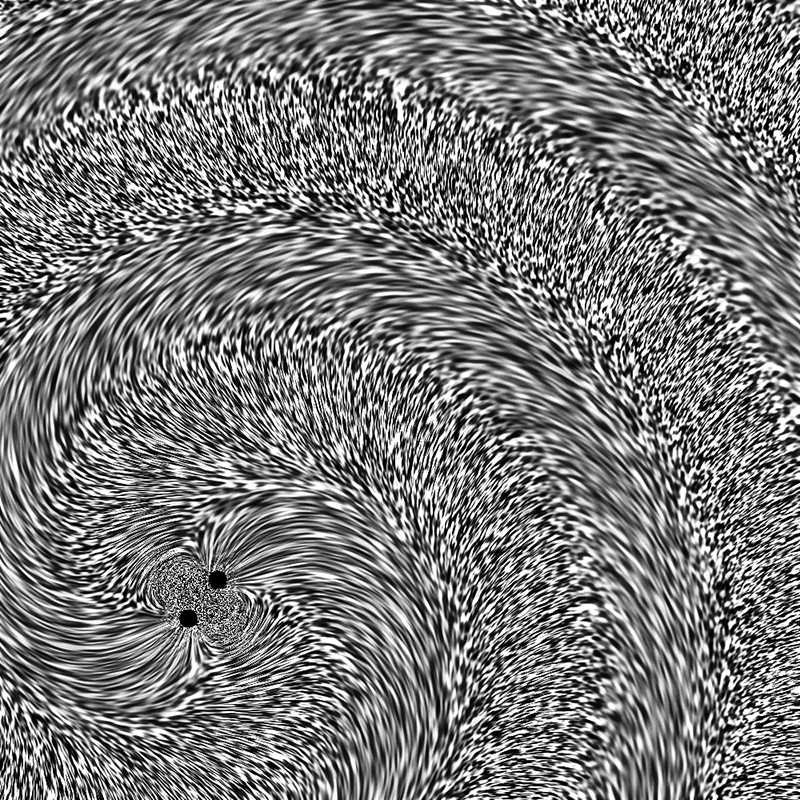Black Hole Collision Confirms Last Piece of Einstein’s Puzzle
A representation of the stretching and squeezing of spacetime caused by the orbiting of two black holes rotating counterclockwise around each other is shown. Scientists from LIGO Scientific Collaboration and Virgo Collaboration recently proved the existence of gravitational waves.
February 26, 2016
A team of scientists announced earlier this month that they had detected gravitational waves, tiny ripples in spacetime, caused by the collision of two black holes more than a billion lightyears away from Earth. The discovery, which many researchers hailed as one of the most significant in a century, is the physical representation of the last of the predictions that would confirm Einstein’s theory of general relativity.
“Not only is it the culmination of a theoretical and experimental effort literally 100 years in the making —Einstein predicted these waves in 1916— but it also represents the first example of an entirely new way to learn about the universe around us,” said Assistant Professor of Physics and Astronomy Dr. Rob Owen in an email to the Review.
Owen’s research focuses on the theoretical aspects of gravitational wave detection.
“I’m involved in a large collaboration of researchers who use supercomputers to calculate the behavior of colliding black holes and the gravitational waves they give off,” Owen said. The computer simulations that calculated the approximate masses of the two black holes that collided, 36 and 29 times the mass of the sun, respectively, used code that Owen helped create.
The two progenitor black holes merged into a single black hole 62 times as massive as the sun, and the remaining three suns worth of mass were converted into energy according to Einstein’s E = mc2 equation, Owen said.
“In that tiny fraction of a second, this pair of black holes gave off more energy than all of the light, from all of the stars, in all of the galaxies, in the entirety of the observable universe, times a thousand,” Owen said. Some of that energy came to Earth as gravitational waves.
Owen explained that, until now, astronomers have only been able to use electromagnetic waves, such as visible light, radio waves and x-rays, to collect information about the cosmos. The confirmation that gravitational waves exist has opened up an entirely new spectrum for researchers to use to detect events in the universe that have been previously invisible to humankind.
In September of last year, the twin Laser Interferometer Gravitational Wave Observatory detectors simultaneously measured the gravitational waves propagated by the abrupt collision of black holes more than a billion years ago. A collaboration of scientists comprised of the LIGO group and another team, known as the Virgo Collaboration, published the results of their findings in Physical Review Letters on Feb. 12, 2016.
The LIGO detectors, located in Livingston, LA, and Hanford, WA, measured the gravitational waves by using an L-shaped configuration of laser beams to detect minute changes in spacetime. When a gravitational wave passes by, one of the “arms” of the L-shape gets slightly longer while the other gets slightly shorter, Owen said, which is why physicists describe gravitational waves as “stretching and squeezing” spacetime.
“Imagine that you’re skydiving, and that while you free-fall, you’re oriented such that your feet are closer to the ground than your head,” Owen said. “Because your feet are a little closer, they are tugged a little bit more strongly by gravity. This means that as you fall you’ll be stretched, ever so slightly — far too slightly to actually feel above the Earth, but if you were skydiving into a black hole, the effect would be very noticeable. We literally call it “spaghettification” in that context.” Owen explained.
Researchers converted the signal from the gravitational waves registered by the LIGO detectors into sound waves. The noise resembles the echo of water dripping in a cave.
“Sometimes, people at the detector site will literally plug headphones into the datastream to see if they can hear gravitational wave events,” Owen said. “None have yet been measured this way, but in principle it’s possible.”



















